#Digital learning solution
Explore tagged Tumblr posts
Text
Explore how digital learning transforms engineering education, fostering interactive, personalised, and collaborative experiences. Discover the impact and explore Magic Marks' innovative platform.
#mechanical video lectures#engineering video lectures online#Digital Learning solution#b.tech study material#study engineering online
0 notes
Text
Why Smallholder Farmers in Western Kenya Are Championing Native Tree Restoration
Smallholders in Western Kenya strongly support native-tree restoration due to long-term benefits for landscape restoration, productivity and livelihoods, new research shows. Digital tools and community buy-in are successfully backing restoration projects A farmer waters seedlings along the Nzoia River in Siaya, Kenya. African nations have grand ambitions to green up landscapes with trees; the…
#afforestation#agroforestry#biodiversity#CGIAR Nature-Positive Solutions#Climate resilience#community engagement#desertification#digital tools#Diversity for Restoration#ecosystem restoration#environmental conservation#Food security#forest landscape restoration#Kenya tree-planting initiative#landscape restoration#livelihood improvement#My Farm Trees#native tree restoration#peer learning#policy interventions#reforestation#restoration initiatives#smallholder farmers#SOIL FERTILITY#sustainable agriculture#sustainable farming#tree diversity#tree planting#tree-based livelihoods#Western Kenya
13 notes
·
View notes
Text
I am going fucking insane do they make drivers ed intentionally brain melting??
Everytime i hear this mans voice i feel like im watching honey crystalize or paint dry or cheese Very Slowly grow moldy
Like i know im overreacting but i cant focus on this?? I have to do 30 hours and its like every time i start watching one of the videos my brain turns off and i cant focus on what hes saying i hate online learning stuff so much
i dont care if i have to go to a classroom just make me learn this in literally any other way than listening to this man reading aloud multiple choice questions from a weirdly formatted slideshow for 30 minutes straight with the crunchiest audio known to man
#i know online learning is probably cheaper#but do you want me to be good at driving or not??#this is kinda important#IF I HEAR THIS GUY GO#And#the correct answer is#C#ONE MORE TIME#vammieposts#i sit in apush lectures for forty minutes everyday and im able to focus#clearly theres a wY to do this so its not so dull#JUST STOP WITH THE MULTIPLE CHOICE QUESITONS I BEF#like who decided this was a good idea?? multiple choice stuff is so repetitibe it all blends togther#and now i remember the wrong answers more often than the cofrect answers!’#drivers ed#i have 25 more hours of this i really dont think i can handle it#yes im overreacting but i cant do busywork i cant focus on dull things i really want to learn this and its not being taught well and that#upsets me a lot#its so so frustrating when theres an easy solution to bad systems and formats#and people dont see it??#it upsets me that so many things are being switched to online when that more often than not makes it MORE difficult??#my schools digital hallpass things??#unique apps to pay for parking in each coty??#digital doesnt automaticaly meant more efficient or convinient#its helpful in some areas#and much worse in others#this drivers ed is the worse end of the spectrum#because instead of being like oh heres the slideshow read it and take the test#it gives you a specific amount of hours you have to spend watching videos#i could just walk away and let the bideo play! like how does that prove that i know anything thats being tuaght??
6 notes
·
View notes
Text

AI’s Role in Business Process Automation
Automation has come a long way from simply replacing manual tasks with machines. With AI stepping into the scene, business process automation is no longer just about cutting costs or speeding up workflows—it’s about making smarter, more adaptive decisions that continuously evolve. AI isn't just doing what we tell it; it’s learning, predicting, and innovating in ways that redefine how businesses operate.
From hyperautomation to AI-powered chatbots and intelligent document processing, the world of automation is rapidly expanding. But what does the future hold?
What is Business Process Automation?
Business Process Automation (BPA) refers to the use of technology to streamline and automate repetitive, rule-based tasks within an organization. The goal is to improve efficiency, reduce errors, cut costs, and free up human workers for higher-value activities. BPA covers a wide range of functions, from automating simple data entry tasks to orchestrating complex workflows across multiple departments.
Traditional BPA solutions rely on predefined rules and scripts to automate tasks such as invoicing, payroll processing, customer service inquiries, and supply chain management. However, as businesses deal with increasing amounts of data and more complex decision-making requirements, AI is playing an increasingly critical role in enhancing BPA capabilities.
AI’s Role in Business Process Automation
AI is revolutionizing business process automation by introducing cognitive capabilities that allow systems to learn, adapt, and make intelligent decisions. Unlike traditional automation, which follows a strict set of rules, AI-driven BPA leverages machine learning, natural language processing (NLP), and computer vision to understand patterns, process unstructured data, and provide predictive insights.
Here are some of the key ways AI is enhancing BPA:
Self-Learning Systems: AI-powered BPA can analyze past workflows and optimize them dynamically without human intervention.
Advanced Data Processing: AI-driven tools can extract information from documents, emails, and customer interactions, enabling businesses to process data faster and more accurately.
Predictive Analytics: AI helps businesses forecast trends, detect anomalies, and make proactive decisions based on real-time insights.
Enhanced Customer Interactions: AI-powered chatbots and virtual assistants provide 24/7 support, improving customer service efficiency and satisfaction.
Automation of Complex Workflows: AI enables the automation of multi-step, decision-heavy processes, such as fraud detection, regulatory compliance, and personalized marketing campaigns.
As organizations seek more efficient ways to handle increasing data volumes and complex processes, AI-driven BPA is becoming a strategic priority. The ability of AI to analyze patterns, predict outcomes, and make intelligent decisions is transforming industries such as finance, healthcare, retail, and manufacturing.
“At the leading edge of automation, AI transforms routine workflows into smart, adaptive systems that think ahead. It’s not about merely accelerating tasks—it’s about creating an evolving framework that continuously optimizes operations for future challenges.”
— Emma Reynolds, CTO of QuantumOps
Trends in AI-Driven Business Process Automation
1. Hyperautomation
Hyperautomation, a term coined by Gartner, refers to the combination of AI, robotic process automation (RPA), and other advanced technologies to automate as many business processes as possible. By leveraging AI-powered bots and predictive analytics, companies can automate end-to-end processes, reducing operational costs and improving decision-making.
Hyperautomation enables organizations to move beyond simple task automation to more complex workflows, incorporating AI-driven insights to optimize efficiency continuously. This trend is expected to accelerate as businesses adopt AI-first strategies to stay competitive.
2. AI-Powered Chatbots and Virtual Assistants
Chatbots and virtual assistants are becoming increasingly sophisticated, enabling seamless interactions with customers and employees. AI-driven conversational interfaces are revolutionizing customer service, HR operations, and IT support by providing real-time assistance, answering queries, and resolving issues without human intervention.
The integration of AI with natural language processing (NLP) and sentiment analysis allows chatbots to understand context, emotions, and intent, providing more personalized responses. Future advancements in AI will enhance their capabilities, making them more intuitive and capable of handling complex tasks.
3. Process Mining and AI-Driven Insights
Process mining leverages AI to analyze business workflows, identify bottlenecks, and suggest improvements. By collecting data from enterprise systems, AI can provide actionable insights into process inefficiencies, allowing companies to optimize operations dynamically.
AI-powered process mining tools help businesses understand workflow deviations, uncover hidden inefficiencies, and implement data-driven solutions. This trend is expected to grow as organizations seek more visibility and control over their automated processes.
4. AI and Predictive Analytics for Decision-Making
AI-driven predictive analytics plays a crucial role in business process automation by forecasting trends, detecting anomalies, and making data-backed decisions. Companies are increasingly using AI to analyze customer behaviour, market trends, and operational risks, enabling them to make proactive decisions.
For example, in supply chain management, AI can predict demand fluctuations, optimize inventory levels, and prevent disruptions. In finance, AI-powered fraud detection systems analyze transaction patterns in real-time to prevent fraudulent activities. The future of BPA will heavily rely on AI-driven predictive capabilities to drive smarter business decisions.
5. AI-Enabled Document Processing and Intelligent OCR
Document-heavy industries such as legal, healthcare, and banking are benefiting from AI-powered Optical Character Recognition (OCR) and document processing solutions. AI can extract, classify, and process unstructured data from invoices, contracts, and forms, reducing manual effort and improving accuracy.
Intelligent document processing (IDP) combines AI, machine learning, and NLP to understand the context of documents, automate data entry, and integrate with existing enterprise systems. As AI models continue to improve, document processing automation will become more accurate and efficient.
Going Beyond Automation
The future of AI-driven BPA will go beyond automation—it will redefine how businesses function at their core. Here are some key predictions for the next decade:
Autonomous Decision-Making: AI systems will move beyond assisting human decisions to making autonomous decisions in areas such as finance, supply chain logistics, and healthcare management.
AI-Driven Creativity: AI will not just automate processes but also assist in creative and strategic business decisions, helping companies design products, create marketing strategies, and personalize customer experiences.
Human-AI Collaboration: AI will become an integral part of the workforce, working alongside employees as an intelligent assistant, boosting productivity and innovation.
Decentralized AI Systems: AI will become more distributed, with businesses using edge AI and blockchain-based automation to improve security, efficiency, and transparency in operations.
Industry-Specific AI Solutions: We will see more tailored AI automation solutions designed for specific industries, such as AI-driven legal research tools, medical diagnostics automation, and AI-powered financial advisory services.
AI is no longer a futuristic concept—it’s here, and it’s already transforming the way businesses operate. What’s exciting is that we’re still just scratching the surface. As AI continues to evolve, businesses will find new ways to automate, innovate, and create efficiencies that we can’t yet fully imagine.
But while AI is streamlining processes and making work more efficient, it’s also reshaping what it means to be human in the workplace. As automation takes over repetitive tasks, employees will have more opportunities to focus on creativity, strategy, and problem-solving. The future of AI in business process automation isn’t just about doing things faster—it’s about rethinking how we work all together.
Learn more about DataPeak:
#datapeak#factr#technology#agentic ai#saas#artificial intelligence#machine learning#ai#ai-driven business solutions#machine learning for workflow#ai solutions for data driven decision making#ai business tools#aiinnovation#digitaltools#digital technology#digital trends#dataanalytics#data driven decision making#data analytics#cloudmigration#cloudcomputing#cybersecurity#cloud computing#smbs#chatbots
2 notes
·
View notes
Text
Boost E-commerce in Saudi Arabia with ML-Powered Apps

In today's digital era, the e-commerce industry in Saudi Arabia is rapidly expanding, fueled by increasing internet penetration and a tech-savvy population. To stay competitive, businesses are turning to advanced technologies, particularly Machine Learning (ML), to enhance user experiences, optimize operations, and drive growth. This article explores how ML is transforming the e-commerce landscape in Saudi Arabia and how businesses can leverage this technology to boost their success.
The Current E-commerce Landscape in Saudi Arabia
The e-commerce market in Saudi Arabia has seen exponential growth over the past few years. With a young population, widespread smartphone usage, and supportive government policies, the Kingdom is poised to become a leading e-commerce hub in the Middle East. Key players like Noon, Souq, and Jarir have set the stage, but the market is ripe for innovation, especially with the integration of Machine Learning.
The Role of Machine Learning in E-commerce
Machine Learning, a subset of Artificial Intelligence (AI), involves the use of algorithms to analyze data, learn from it, and make informed decisions. In e-commerce, ML enhances various aspects, from personalization to fraud detection. Machine Learning’s ability to analyze large datasets and identify trends is crucial for businesses aiming to stay ahead in a competitive market.
Personalized Shopping Experiences
Personalization is crucial in today’s e-commerce environment. ML algorithms analyze user data, such as browsing history and purchase behavior, to recommend products that align with individual preferences. This not only elevates the customer experience but also drives higher conversion rates. For example, platforms that leverage ML for personalization have seen significant boosts in sales, as users are more likely to purchase items that resonate with their interests.
Optimizing Inventory Management
Effective inventory management is critical for e-commerce success. ML-driven predictive analytics can forecast demand with high accuracy, helping businesses maintain optimal inventory levels. This minimizes the chances of overstocking or running out of products, ensuring timely availability for customers. E-commerce giants like Amazon have successfully implemented ML to streamline their inventory management processes, setting a benchmark for others to follow.
Dynamic Pricing Strategies
Price is a major factor influencing consumer decisions. Machine Learning enables real-time dynamic pricing by assessing market trends, competitor rates, and customer demand. This allows businesses to adjust their prices to maximize revenue while remaining competitive. Dynamic pricing, powered by ML, has proven effective in attracting price-sensitive customers and increasing overall profitability.
Enhanced Customer Support
Customer support is another area where ML shines. AI-powered chatbots and virtual assistants can handle a large volume of customer inquiries, providing instant responses and resolving issues efficiently. This not only improves customer satisfaction but also reduces the operational costs associated with maintaining a large support team. E-commerce businesses in Saudi Arabia can greatly benefit from incorporating ML into their customer service strategies.
Fraud Detection and Security
With the rise of online transactions, ensuring the security of customer data and payments is paramount. ML algorithms can detect fraudulent activities by analyzing transaction patterns and identifying anomalies. By implementing ML-driven security measures, e-commerce businesses can protect their customers and build trust, which is essential for long-term success.
Improving Marketing Campaigns
Effective marketing is key to driving e-commerce success. ML can analyze customer data to create targeted marketing campaigns that resonate with specific audiences. It enhances the impact of marketing efforts, leading to improved customer engagement and higher conversion rates. Successful e-commerce platforms use ML to fine-tune their marketing strategies, ensuring that their messages reach the right people at the right time.
Case Study: Successful E-commerce Companies in Saudi Arabia Using ML
Several e-commerce companies in Saudi Arabia have already begun leveraging ML to drive growth. For example, Noon uses ML to personalize the shopping experience and optimize its supply chain, leading to increased customer satisfaction and operational efficiency. These companies serve as examples of how ML can be a game-changer in the competitive e-commerce market.
Challenges of Implementing Machine Learning in E-commerce
While the benefits of ML are clear, implementing this technology in e-commerce is not without challenges. Technical hurdles, such as integrating ML with existing systems, can be daunting. Additionally, there are concerns about data privacy, particularly in handling sensitive customer information. Businesses must address these challenges to fully harness the power of ML.
Future Trends in Machine Learning and E-commerce
As ML continues to evolve, new trends are emerging that will shape the future of e-commerce. For instance, the integration of ML with augmented reality (AR) offers exciting possibilities, such as virtual try-ons for products. Businesses that stay ahead of these trends will be well-positioned to lead the market in the coming years.
Influence of Machine Learning on Consumer Behavior in Saudi Arabia
ML is already influencing consumer behavior in Saudi Arabia, with personalized experiences leading to increased customer loyalty. As more businesses adopt ML, consumers can expect even more tailored shopping experiences, further enhancing their satisfaction and engagement.
Government Support and Regulations
The Saudi government is proactively encouraging the integration of cutting-edge technologies, including ML, within the e-commerce industry. Through initiatives like Vision 2030, the government aims to transform the Kingdom into a global tech hub. However, businesses must also navigate regulations related to data privacy and AI to ensure compliance.
Conclusion
Machine Learning is revolutionizing e-commerce in Saudi Arabia, offering businesses new ways to enhance user experiences, optimize operations, and drive growth. By embracing ML, e-commerce companies can not only stay competitive but also set new standards in the industry. The future of e-commerce in Saudi Arabia is bright, and Machine Learning will undoubtedly play a pivotal role in shaping its success.
FAQs
How does Machine Learning contribute to the e-commerce sector? Machine Learning enhances e-commerce by improving personalization, optimizing inventory, enabling dynamic pricing, and enhancing security.
How can Machine Learning improve customer experiences in e-commerce? ML analyzes user data to provide personalized recommendations, faster customer support, and tailored marketing campaigns, improving overall satisfaction.
What are the challenges of integrating ML in e-commerce? Challenges include technical integration, data privacy concerns, and the need for skilled professionals to manage ML systems effectively.
Which Saudi e-commerce companies are successfully using ML? Companies like Noon and Souq are leveraging ML for personalized shopping experiences, inventory management, and customer support.
What is the future of e-commerce with ML in Saudi Arabia? The future looks promising with trends like ML-driven AR experiences and more personalized
#machine learning e-commerce#Saudi Arabia tech#ML-powered apps#e-commerce growth#AI in retail#customer experience Saudi Arabia#digital transformation Saudi#ML app benefits#AI-driven marketing#predictive analytics retail#Saudi digital economy#e-commerce innovation#smart retail solutions#AI tech adoption#machine learning in business
2 notes
·
View notes
Text

The geniuses at the head of Logitech rigth now...
#The geniuses at the head of Logitech rigth now...#logitech#artificial intelligence#ai powered authoring tool#ai powered learning platform#ai powered digital marketing#ai powered solutions#ai powered tool#ai powered#ai generated#ai art#ai girl#ai artwork#ai#a.i. art#a.i. generated#a.i.#ausgov#politas#auspol#tasgov#taspol#australia#fuck neoliberals#neoliberal capitalism#anthony albanese#albanese government
2 notes
·
View notes
Text
Why Your Business Needs a Cloud Video Platform Today

In the digital era, businesses are constantly looking for ways to enhance efficiency, reduce costs, and improve communication and collaboration. One of the technological advances that has been pivotal in achieving these objectives is the cloud video platform. This platform has revolutionized how businesses operate, offering a multitude of benefits ranging from improved communication strategies to expansive data analytics. Additionally, the cloud video platform provides scalable solutions that adapt to the needs of growing businesses, ensuring that they can maintain seamless operations. By facilitating remote work and virtual meetings, these platforms also contribute to better team collaboration and more efficient project management.
Key Benefits of Using Cloud Video Platform
A cloud video platform offers significant advantages to businesses, paramount among them being scalability, accessibility, enhanced collaboration, cost-effectiveness, and security. Understanding these benefits in detail can help organizations make informed decisions about adopting this technology, leading to more efficient operations, improved communication, and ultimately, a competitive edge in the market. Embracing cloud video solutions is a strategic move.
Scalability and Flexibility
One of the primary advantages of cloud video platform is their scalability. Businesses can effortlessly scale their video management needs up or down based on current demand without the need for significant upfront investments in hardware. This flexibility is crucial in adapting to business growth or changes without incurring additional costs or delays. Moreover, it allows companies to efficiently manage resources and respond promptly to evolving market conditions.
Accessibility and Reach
With a cloud video platform, videos can be accessed from anywhere, at any time, on any device with internet access. This global accessibility ensures that employees in different locations can easily participate in training sessions, meetings, and collaborations without the need for physical travel, further enhancing productivity across the organization. Additionally, it allows for seamless integration of remote and on-site teams, fostering a more connected and efficient workplace.
Enhanced Collaboration
A cloud video platform facilitates enhanced collaboration among teams by providing features such as real-time sharing, editing, and communication tools. These integrated features enable teams to work together more effectively, even when members are spread across various geographic locations. This real-time interaction significantly aids in quicker decision-making and problem-solving, ensuring that projects progress smoothly and efficiently regardless of physical distances.
Cost-Effectiveness
Moving to a cloud video platform can significantly reduce costs related to video content management. By leveraging cloud services, businesses eliminate the need for expensive on-premise infrastructure. Additionally, the maintenance and upgrading of systems are handled by the service provider, which can further decrease IT expenses. Furthermore, cloud platforms offer scalable solutions that allow businesses to pay only for the resources they use, optimizing budget allocation.
Security and Compliance
Security is a top concern for any business leveraging digital tools. The cloud video platform is equipped with robust security measures, including data encryption, secure access controls, and compliance with international standards. These features ensure that sensitive content remains protected against unauthorized access and breaches. Additionally, regular security audits and updates further enhance the platform's ability to safeguard valuable data, providing businesses with peace of mind and confidence in their digital security.
Improved Content Management and Analytics
A cloud video platform also offers advanced content management systems, allowing businesses to efficiently organize, manage, and retrieve video content with ease. Additionally, these platforms provide insightful analytics on viewer engagement, content performance, and other key metrics. This data-driven approach enables businesses to make informed decisions to optimize their video strategies, enhance viewer experience, and ultimately drive better results in their video marketing efforts.
Implementing Cloud Video Platform: Considerations and Best Practices
Implementing a cloud video platform yields significant benefits, but its success hinges on strategic planning and factor consideration. Vital elements encompass selecting an appropriate platform, meeting bandwidth needs, prioritizing user adoption tactics, and upholding data governance policies. These measures collectively shape a robust foundation for seamless integration and optimized performance.
Choosing the Right Platform
Selecting the appropriate cloud video platform is critical and should be based on specific business needs such as feature requirements, scalability, security, and compatibility with existing systems. Businesses should conduct thorough research or consult with experts to find the best fit.
Ensuring Adequate Bandwidth
Effective video streaming requires sufficient bandwidth. Before implementation, businesses need to assess their internet bandwidth to ensure smooth video playback and uploading capabilities without disrupting other business operations.
Focusing on User Adoption
To maximize the benefits of cloud video platform, promoting user adoption through training and support is essential. Employees need to understand how to use the platform efficiently and be comfortable with its features to fully leverage its capabilities.
Adhering to Data Governance
Businesses must also consider data governance when implementing cloud video platform. Ensuring that the platform complies with relevant laws and regulations regarding data privacy and protection is crucial.
Conclusion
The adoption of a cloud video platform can bring transformative benefits to businesses, fostering better communication and collaboration, providing scalability and flexibility, enhancing content management and analytics, reducing costs, and bolstering security. By leveraging cloud technology, organizations can streamline their operations and improve efficiency. Moreover, these platforms enable seamless remote work, support real-time collaboration, and offer advanced tools for data-driven decision-making. With careful planning and consideration of the key factors outlined above, organizations can effectively implement and use these platforms to achieve substantial business success, ensuring they stay competitive in an increasingly digital and connected world. please don’t hesitate to contact us via email or phone for further assistance!
#cloud video platform#secure video hosting#streaming video hosting#encrypted video hosting#drm encrypted video streaming#encrypted video streaming#DRM software#video hosting#security video#video platforms#online video platform#video watermark#DRM protected content#video cdn#wide vine#online courses#e-learning platforms#influencers#paid online courses#E-Learning Solutions#Digital content
2 notes
·
View notes
Text
Learn: How Smartphone Apps Are Changing the Game!
Are you looking for CBSE Syllabus, Then Subscribe to Digital Teacher Canvas Online learning classes for just 1949 rupees only.
#smart classroom#digital classroom#digi class#online learning app#elearning#study online#learning application#online classroom#digital learning#learning app#online learning platform#online education#digital education#online classes#digital class software#digital class solution#online learning#software#technology
4 notes
·
View notes
Text
IETM for Beginners A Quick Guide to IETM Code and Pixels
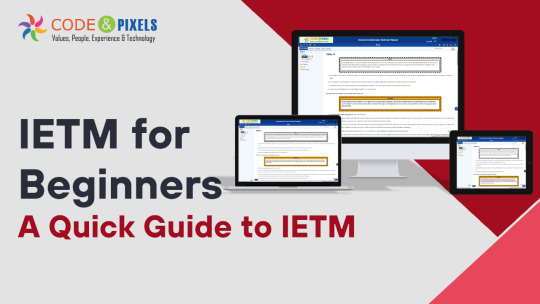
IETM: Interactive Electronic Technical Manual
Training Aids to Defence Client
If you are a supplier of defence then along with the system/equipment you also need to provide Training Aids
(CBT) — Computer-Based Training
Charts and Bloups
Video Film
Training Work Modules
Manuals Hard Copies
IETM
Evolution of Documentation in Defence
Before — Hardcopies and PDFs in DVDs (Upto 2015)
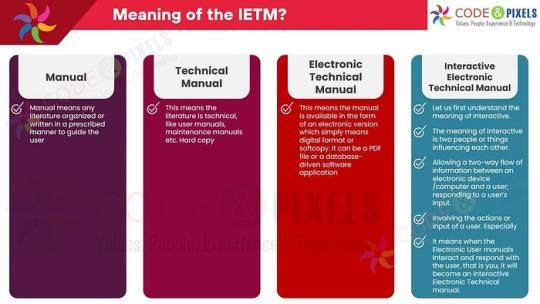
What is the meaning of the IETM?
Manual: Manual means any literature organized or written in a prescribed manner to guide the user.
TechnicalManual: This means the literature is technical, like user manuals, maintenance manuals etc. Hard copy
Electronic Technical Manual: This means the manual is available in the form of an electronic version which simply means digital format or softcopy. It can be a PDF file or a database-driven software application.
Interactive Electronic Technical Manual:
Let us first understand the meaning of Interactive. The meaning of interactive is two people or things influencing each other.
Allowing a two-way flow of information between an electronic device /computer and a user; responding to a user’s input.
Involving the actions or input of a user. Especially
It means when the Electronic User manuals Interact and respond with the user, that is you, it will become an Interactive Electronic Technical manual.
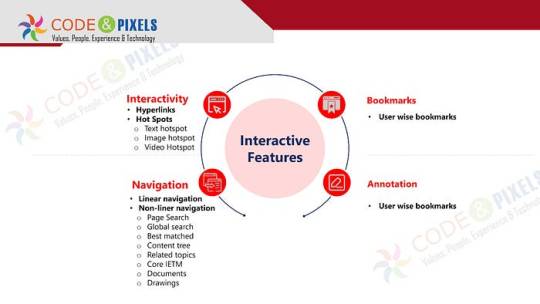
Interactive Features
Interactivity
Hyperlinks
Hot Spots
Text hotspot
Image hotspot
VideHotspot
Bookmarks
User wise bookmarks
Navigation
Linear navigation
Non-liner navigation
Page Search
Global search
Best matched
Content tree
Related topics
Core IETM
Documents
Drawings
Annotation
User wise bookmarks
The documents and pages are many hence, for easy and fast accessibility complete content is converted and stored as a database.
Whenever the user wants some information, IETM software produces the information in a fraction of a second.
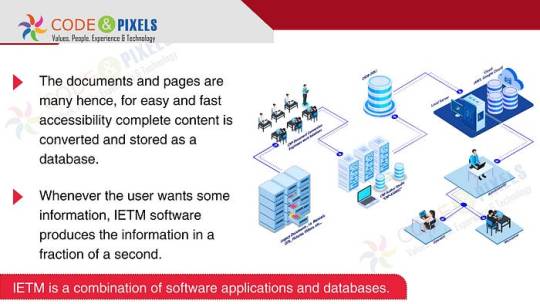
Use or Purpose of the IETM?
The purpose of the Manual is to give information related to the equipment to the end user for quick reference.
All the technicality is written in detail so that when an issue arises, the user can refer to the manual, as every time OEM or technical person or subject matter expert might not be available on the spot to resolve the issue.
If the manual has 10 pages users can refer easily.
But any system used by the defence will have multiple manuals and thousands of page counts and many times a user has to cross-refer between manuals, intra-manual and inter-manual to resolve the issue.
Referring to 10- 15 hard-copy or even soft-copy books simultaneously will be difficult and time-consuming.
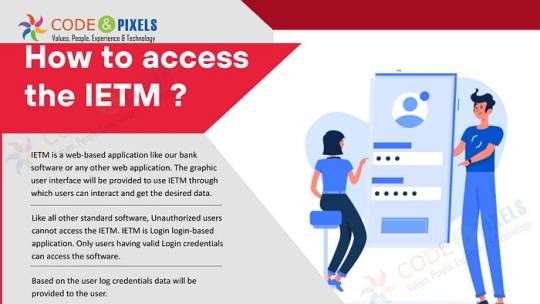
How to access the IETM ?
IETM is a web-based application like our bank software or any other web application. The graphic user interface will be provided to use IETM through which users can interact and get the desired data.
Like all other standard software, Unauthorized users cannot access the IETM. IETM is a Login - login-based application. Only users having valid Login credentials can access the software.
Based on the user log credentials data will be provided to the user.
IETM has 2 types of Users and one Administrator
Maintainer
Operator
If the operator logs in, the user gets all the content related to operator use, similarly if the maintainer logs in only maintenance-related content is visible for that user.
Ideally, all the content is available for both users, because the purpose of the IETM is to refer to the manual to fix the issue.
Administrators can create users who can see the user’s navigation and log-in history and interact with the users using user dashboards through Annotations.
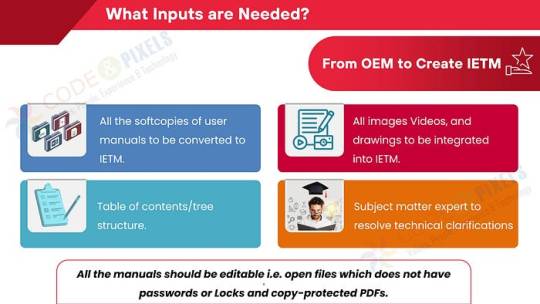
What Inputs are Needed? (From OEM to Create IETM)
All the softcopies of user manuals to be converted to IETM.
All images Videos, and drawings to be integrated into IETM.
Subject matter expert to resolve technical clarifications
Table of contents/tree structure.

Minimum Hardware Requirements?
NO High-end hardware or servers are required to run IETM.
However, if more concurrent users, then a good configuration server with good LAN connectivity must be ensured.
i3 with 8 GB RAM systems is the minimum configuration required for the server or for Node.
Deliverables
BASED DB (Manuals are covered in the Database)
IETM VIEWER Software
User Manual and Installation Manual
Standards — compliance
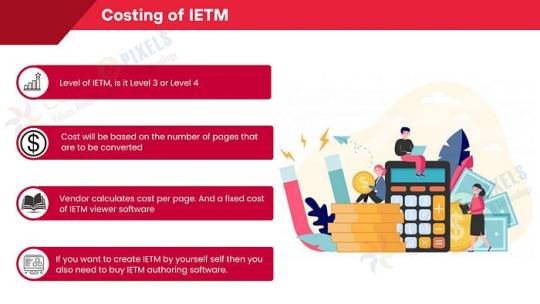
Costing of IETM: (Interactive Electronic Technical Manual)
Level of IETM, is it Level 3 or Level 4
Cost will be based on the number of pages that are to be converted
The vendor calculates the cost per page. And a fixed cost of IETM viewer software
If you want to create IETM by yourself self then you also need to buy IETM authoring software.
What are these Levels?
Level — 1 is any PDF file
Level — 2 is a PDF file with hyperlinks from the table of contents to the body etc.
Level — 3 is an HTML application. More hyperlinks, simple search, a content tree having log a screen with a hardcoded username and password and supplied in the format of EXE so that Windows can easily open
Level — 4 is Software plus Content/manuals converted as Database
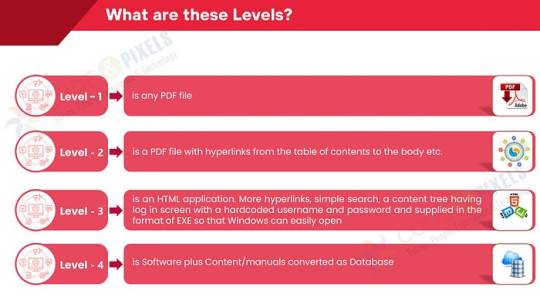
Regarding Level — 5, rest assured, till 2028 it will be Level — 4 only. As of now, there is nothing practically called Level — 5. Few are calling virtual reality and Augmented reality and Artificial intelligence Level — 5.
Pulling data from many user inputs and analyzing and giving results are done in Level — 5. IETM software cannot pull the data from various real-time points as No OEM will give the real-time information to third-party software directly. Yes, if the information is available offline, then that information can be imported into IETM and can be used as a reference.

#ietm#software#technology#ietm developement#ietm code and pixels ietm hyderabad#ietm software#elearning#code and pixels#ietm level iv#codeandpixels#ietm level 4 software requirements#technical documentation#ietm document#ietm documentation#interactive electronic technical manual#Ietm Service Providers#Ietm Software Designers of India#Software Development Company#Elearning Solutions Company#E Learning Content Development Company#Online Education#Digital Education#Digital Content#Software Development Solutions#Elearning#Ietm Developers#Econtent Development#Elearning Solutions Providers#Econtent Developers#Econtent
3 notes
·
View notes
Text
The Internet of Things (IoT): A Revolution in Connectivity
The world as we know it is rapidly transforming thanks to the Internet of Things ( IoT ). IoT is paving the way for a new era of interconnectedness, revolutionizing the way we interact with technology, and reshaping various aspects of our daily lives. In this article, we’ll delve into the concept of IoT, its diverse applications, and the significance of understanding this transformative technology. We’ll also introduce a fundamental course that will help individuals explore IoT in-depth.
#Power of Connectivity the Revolution of IoT with this Free Course#Power of Connectivity#Revolution of IoT#Free Course#Internet of Things#Connectivity#IoT Revolution#Technology Trends#Emerging Technologies#Connectivity Solutions#IoT Education#Digital Transformation#Free Learning#Smart Devices#IoT Applications#Connected World#IoT Training#Connectivity Revolution#IoT Innovation#Free Educational Resources#Tech Revolution#freeudemy
2 notes
·
View notes
Text
Digital learning in engineering enhances understanding and retention, improves academic performance, fosters practical skills, and encourages global collaboration.
#e-learning engineering courses#mechanical engineering tutorial#Digital learning solution#Engineering Video Lectures#Engineering Video tutorials#Elearning Platforms#Btech Students
0 notes
Text
CBSE Schools Digital Teacher
Central Board Of Secondary Education, commonly known as CBSE is constituted in the year of 1952. However, in the year of 1962 the board extended its wings, which not only have PAN India presence, but also spread across various continents.
https://www.digitalteacher.in/blog/cbse-schools-digital-teacher/
#smart classroom#digital classroom#digi class#online learning app#elearning#study online#learning application#online classroom#digital learning#learning app#online learning platform#online education#digital education#online classes#digital class software#digital class solution#online learning#software#technology#education#education technology#smart class#digital teacher#smart class solution#smart classroom software#elearning software#digital teacher#digital teacher canvas
2 notes
·
View notes
Text
It's absolutely a deterrent especially for folks who've never been to a protest. There's this idea that you have to Gear Up And Prepare for ANY action even just like, a simple picket or march, so folks think protesting is Always some violent dystopian Struggle with severe risk of personal harm and arrest. And while yeah, sometimes they do go badly and these things do happen, it is NOT the majority of action and most events are relatively boring risk-wise.
Like, no you don't need full black bloc gear to hold a sign for a permitted 2hr sidewalk protest, and you don't need shields and gas masks and jugs of milk for daytime local-issue demonstration of civic dissatisfaction. PLEASE just show up. If there are risks, the organizers will be able to tell you what they are and how to prepare.
The most 'risky' protests I've been to have all been either systemic, ongoing, and/or continued into late evening after sundown. They were still all highly organized, and the leading experienced activists were very clear on strategy and risks. Typically, any policing threats were made obvious by the cops changing from 'standing around looking bored' to 'organizing into groups/lines', so if you're not prepared to Resist for any reason -- zero judgement, there are so many reasons and they're no one's business but yours -- that's when you leave.
For now we still have the right to protest, and the majority of action will be calm and organized. There will be lots of in-group mediating and de-escalation if folks come in looking to start shit, and just showing up is an EXCELLENT way to meet local activists and justice groups/networks, many of whom work together on many different issues.
Even if you cannot stay or participate there are other ways to help, like delivering/dropping off water (or snacks!), donating to involved groups or bail funds, donating/lending canopy tents and seating for elderly and disabled activists, and volunteering labor like childcare, transportation, distributing materials/info, making signs and posters, translating/interpreting, and more.
And most modern protests work hard to make their actions more accessible or will work with you to ensure you and others like you can access them! If you cannot or do not want to march a route, there is still much more work that can be done both before and after, and not every action is a march!
Just please show up whenever and however you can, whatever that means to you and your circumstances.
i also think that the way people on here talk about protests is sometimes needlessly fearmongering like it's always good to have your wits about you and be aware of dangers from cops or counterprotesters but also i feel like a lot of people on here have become convinced that by going to a large peaceful protest march they are taking their lives in their hands which is just simply not the case (the point of those events is optics and showing that a lot of people are willing to show up for the cause) and i'm worried it might be deterring people from actually showing up to protests
#activism#like for real just showing up and talking to ppl is a HUGE DEAL#and it can give you SO many outlets to pressure for change#like a big action might have multiple justice orgs attending/coordinating#and by talking to them you can learn about future actions and efforts you can help with#there's also a sentiment online of 'idk what to do im so frustrated about xyz'#and genuinely the solution is to reach out to local activist groups#see whats going on and how you can help#you can say 'i cant do abc because of xyz how can i help' and they'll genuinely work with you. no judgement#seriously we need more people involved and organized instead of venting into the digital void#and it can be hard for more rural folks but there are still ways to be involved that don't drain your soul dry#like doomscrolling and borrowed trauma/rage does#even smaller protests/actions can help you get the experience you need to create/join larger actions#or to organize for other issues you care about#please just show up and/or talk to your local activists#and bonus: i met my wife at a protest :)
7K notes
·
View notes
Text
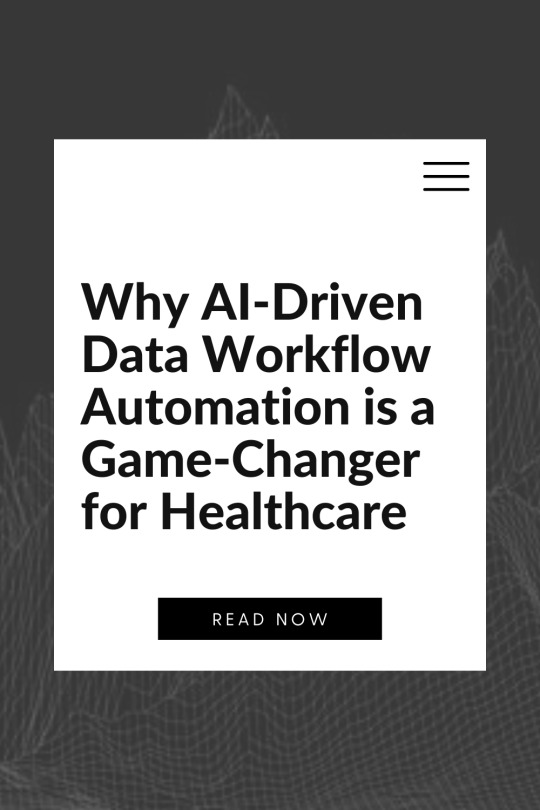
Why AI-Driven Data Workflow Automation is a Game-Changer for Healthcare
The healthcare industry is one of the most complex and data-intensive sectors, dealing with vast amounts of patient records, medical imaging, research data, billing, and administrative processes. Historically, these workflows have been manually managed, leading to inefficiencies, errors, and delays in patient care. AI-driven data workflow automation is transforming healthcare by streamlining processes, enhancing accuracy, and improving overall patient outcomes. In this blog, we will explore how AI-powered automation is revolutionizing healthcare, its benefits, real-world applications, and what the future holds for this groundbreaking technology.
The Need for Automation in Healthcare
Healthcare systems globally are struggling with challenges such as:
Overwhelming administrative burdens
Rising operational costs
Increasing patient expectations for faster and more personalized care
The need for better compliance with regulations such as HIPAA and GDPR
Data silos between hospitals, clinics, and insurance providers
AI-driven workflow automation addresses these challenges by automating repetitive tasks, integrating data sources, and improving decision-making capabilities through predictive analytics.
Key Benefits of AI-Driven Workflow Automation in Healthcare
1. Improved Efficiency and Productivity
AI can automate tasks such as scheduling appointments, processing insurance claims, and managing electronic health records (EHR). This reduces the administrative workload on healthcare staff, allowing them to focus on patient care.
2. Enhanced Accuracy and Reduced Errors
Manual data entry and processing errors can lead to misdiagnoses, incorrect billing, and treatment delays. AI-driven automation minimizes these risks by ensuring accurate data input, processing, and analysis.
3. Faster and More Personalized Patient Care
AI-powered chatbots and virtual assistants can help patients book appointments, receive reminders, and get answers to medical inquiries. Machine learning algorithms analyze patient data to recommend personalized treatment plans.
4. Cost Reduction
By automating repetitive and time-consuming tasks, healthcare organizations can cut labor costs and reduce operational expenses, making medical care more affordable and efficient.
5. Better Compliance and Security
AI-driven solutions ensure that sensitive patient data is handled according to regulatory requirements. Automated workflows can track and report compliance issues in real time, reducing legal risks for healthcare providers.
Applications of AI-Driven Data Workflow Automation in Healthcare
1. Electronic Health Records (EHR) Management
AI-powered automation helps in data extraction, categorization, and updating patient records without human intervention. This ensures real-time access to accurate and up-to-date information for doctors and medical staff.
2. Medical Imaging and Diagnostics
AI-driven image recognition tools can quickly analyze X-rays, MRIs, and CT scans, assisting radiologists in detecting diseases like cancer, fractures, and neurological disorders with high accuracy.
3. Appointment Scheduling and Patient Engagement
AI-powered chatbots and virtual assistants can handle appointment scheduling, send reminders, and answer patient queries, reducing the burden on healthcare staff and improving patient satisfaction.
4. Billing and Insurance Claims Processing
Automation streamlines medical billing by detecting errors, verifying insurance claims, and ensuring compliance with coding standards, leading to faster reimbursements and fewer claim denials.
5. Predictive Analytics for Disease Prevention
Machine learning algorithms analyze patient history, lifestyle, and genetic factors to predict disease risks and recommend preventive measures, helping reduce hospital admissions and improving public health outcomes.
6. Clinical Trials and Research
AI accelerates clinical trials by automating data collection, patient recruitment, and analysis of medical research, leading to faster drug development and approvals.
7. Telemedicine and Remote Patient Monitoring
AI-powered automation enables remote patient monitoring through wearable devices that collect and analyze health data in real time, allowing doctors to intervene before conditions worsen.
Real-Life Case Studies in AI-Driven Healthcare Automation
Case Study 1: Mayo Clinic – AI for Early Disease Detection
The Mayo Clinic, a renowned medical research center, has integrated AI-driven automation into its workflow to enhance early disease detection. One notable example is its use of AI-powered imaging analysis to detect heart disease and certain types of cancer earlier than traditional methods. By leveraging machine learning algorithms, Mayo Clinic's AI systems analyze thousands of medical images to identify patterns that may indicate disease, helping doctors make more accurate diagnoses faster. This AI-driven approach has significantly reduced diagnostic errors and improved patient outcomes, demonstrating the power of AI in predictive medicine.
Case Study 2: Mount Sinai Health System – AI-Powered Radiology Workflow
Mount Sinai Health System in New York has implemented AI automation in its radiology department to streamline image analysis and reporting. The hospital's AI-driven workflow automates the sorting and prioritization of medical images, allowing radiologists to focus on the most urgent cases first. By analyzing CT scans, MRIs, and X-rays in real time, the AI system flags abnormalities such as tumors, fractures, and internal bleeding, expediting the diagnostic process. This has reduced patient wait times and improved treatment planning, showcasing how AI can enhance efficiency in high-demand medical environments.

Challenges and Considerations
Despite its advantages, AI-driven workflow automation in healthcare comes with challenges:
Data Privacy and Security: Ensuring that AI systems comply with HIPAA, GDPR, and other regulations is crucial to protecting patient data.
Integration with Legacy Systems: Many hospitals still use outdated systems that may not easily integrate with AI-powered solutions.
Trust and Adoption: Healthcare professionals may be skeptical of AI-based decision-making and need proper training to understand its benefits.
Cost of Implementation: While AI-driven automation leads to cost savings in the long run, the initial investment can be high for smaller healthcare providers.
The Future of AI-Driven Workflow Automation in Healthcare
The future of AI in healthcare looks promising, with advancements such as:
AI-powered robotics for surgeries and rehabilitation – Surgical robots are becoming more precise, allowing for minimally invasive procedures with faster recovery times. AI-driven robotic-assisted surgeries will enhance accuracy and reduce risks.
Natural Language Processing (NLP) for better doctor-patient communication – AI-powered NLP will improve how healthcare providers interact with patients, translating complex medical jargon into simple terms and enabling voice-driven medical documentation.
Blockchain for secure and decentralized patient data management – AI and blockchain will combine to ensure patient records are secure, tamper-proof, and easily accessible across healthcare institutions.
AI-driven drug discovery and personalized medicine – AI is accelerating drug development by analyzing vast datasets to identify potential treatments and tailoring medications to individual genetic profiles.
AI-integrated wearable technology for proactive healthcare – Smart wearables with AI capabilities will track vital signs, detect anomalies, and alert healthcare providers before health issues escalate.
AI-driven mental health support – AI-powered chatbots and virtual therapists will assist in detecting and managing mental health conditions, making mental healthcare more accessible.
AI in emergency and disaster response – AI will play a crucial role in detecting disease outbreaks, optimizing hospital responses, and assisting in large-scale disaster management efforts.
As AI continues to evolve, its impact on healthcare will only grow, making medical services more efficient, accurate, and accessible.
AI-driven data workflow automation is undeniably a game-changer for the healthcare industry. By improving efficiency, reducing costs, and enhancing patient care, AI is paving the way for a smarter, data-driven healthcare ecosystem. While challenges remain, ongoing advancements and regulatory compliance measures will ensure that AI-powered automation becomes a standard practice in healthcare. The integration of AI-driven automation is the future of modern healthcare.
Learn more about DataPeak:
#datapeak#factr#saas#technology#agentic ai#artificial intelligence#machine learning#ai#ai-driven business solutions#machine learning for workflow#ai solutions for data driven decision making#ai business tools#artificialintelligence#aiinnovation#digital trends#digital technology#digitaltools#datadrivendecisions#dataanalytics#data driven decision making#data analytics#workflowautomation#best ai tools for data pipeline automation#ai platform for business process automation#ai driven data workflow automation#healthcare#ai healthcare
0 notes
Text
From Code to Cognitive – Atcuality’s Intelligent Tech Framework
Atcuality is redefining enterprise success by delivering powerful, scalable, and intelligent software solutions. Our multidisciplinary teams combine cloud-native architectures, agile engineering, and business domain expertise to create value across your digital ecosystem. Positioned at the crossroads of business transformation and technical execution, artificial intelligence plays a vital role in our delivery model. We design AI algorithms, train custom models, and embed intelligence directly into products and processes, giving our clients the edge they need to lead. From automation in finance to real-time analytics in healthcare, Atcuality enables smarter decisions, deeper insights, and higher efficiency. We believe in creating human-centered technology that doesn’t just function, but thinks. Elevate your systems and your strategy — with Atcuality as your trusted technology partner.

#seo services#artificial intelligence#iot applications#seo agency#seo company#seo marketing#digital marketing#azure cloud services#ai powered application#amazon web services#ai image#ai generated#ai art#ai model#technology#chatgpt#ai#ai artwork#ai developers#ai design#ai development#ai deep learning#ai services#ai solutions#ai companies#information technology#software#applications#app#application development
0 notes
Text
Migrating Legacy Contact Centers to Smart AI Solutions

Introduction
In an era dominated by digital transformation, businesses are rapidly shifting from traditional, on-premise contact center systems to smart, AI-powered platforms. This migration is not merely a trend—it’s a strategic imperative. Legacy contact centers, while once reliable, often struggle to keep up with the demands of modern customers who expect seamless, real-time, omnichannel support. Smart AI solutions offer a scalable, efficient, and intelligent approach to managing customer interactions while significantly improving the overall customer experience (CX).
Why Legacy Contact Centers Fall Short
Legacy contact centers were built to handle voice calls through physical infrastructure and manual workflows. These systems are rigid, expensive to maintain, and lack the flexibility needed for today’s fast-paced digital environment. Some key limitations include:
Limited scalability
High operational costs
Minimal integration with digital channels
Lack of real-time data analytics
Inability to support remote agents effectively
Moreover, legacy systems are often siloed, making it difficult to provide a unified customer experience across channels such as email, chat, social media, and messaging apps.
The Case for AI-Powered Contact Centers
AI contact centers leverage technologies like machine learning, natural language processing (NLP), and robotic process automation (RPA) to enhance and automate customer interactions. These platforms can intelligently route queries, provide self-service options, and analyze customer sentiment in real time.
Key benefits of migrating to a smart AI solution include:
Enhanced customer experience (CX) with personalized, context-aware interactions
24/7 availability through AI-powered virtual agents and chatbots
Omnichannel support that unifies communication across voice, email, chat, SMS, and social platforms
Cost savings through intelligent automation and reduced reliance on live agents
AI-driven analytics for better decision-making and performance optimization
Key Technologies Powering Smart AI Contact Centers
Natural Language Processing (NLP) NLP enables AI to understand and respond to human language more effectively. It powers chatbots, virtual assistants, and intelligent IVRs, making interactions more human-like and intuitive.
Machine Learning and Predictive Analytics Machine learning models analyze historical data to predict customer behavior, enabling proactive service and intelligent routing of interactions to the right agents or systems.
AI-Driven Automation Robotic process automation (RPA) handles repetitive tasks such as data entry, verification, and ticket generation, allowing agents to focus on complex issues.
Cloud-Based Infrastructure Modern AI contact centers are built on the cloud, enabling easy scalability, remote agent support, and seamless updates without downtime.
Speech Recognition and Sentiment Analysis These tools analyze tone and emotion during voice interactions, helping organizations adapt responses in real time to improve outcomes.
The Migration Journey: Key Steps and Best Practices
Migrating to a smart AI contact center requires strategic planning and execution. Here’s a high-level roadmap:
1. Assess Your Current State
Begin with a comprehensive audit of your existing contact center infrastructure, workflows, customer pain points, and technology stack. Identify gaps in CX, agent productivity, and system performance.
2. Define Your Objectives
Clearly define your goals—whether it's improving response times, enabling omnichannel support, or reducing costs through automation. These objectives will guide technology selection and implementation strategy.
3. Choose the Right AI Contact Center Platform
Look for platforms that offer:
Seamless cloud migration
Integration with your existing CRM and support systems
AI-powered virtual agents and intelligent routing
Real-time dashboards and AI-driven analytics
Security and compliance features
Top vendors include Amazon Connect, Google Cloud Contact Center AI, Genesys Cloud, and Five9.
4. Plan for Integration and Data Migration
Ensure that customer data, interaction history, and knowledge bases are migrated securely and accurately. APIs and middleware tools can help integrate legacy systems during the transition phase.
5. Train AI Models and Agents
Leverage historical interaction data to train your virtual assistants and automation tools. Concurrently, provide your human agents with training on new tools and AI-assisted workflows.
6. Monitor, Optimize, and Iterate
Post-migration, continuously monitor system performance, customer feedback, and agent productivity. Use AI-driven analytics to identify areas for improvement and adapt quickly.
Addressing Common Challenges
Data Privacy and Compliance: Ensure your new platform adheres to regulations such as GDPR, HIPAA, or PCI-DSS. AI systems should handle sensitive information responsibly.
Change Management: Prepare your team for the cultural shift. AI is meant to augment—not replace—human agents. Empower them with AI tools to work more efficiently.
Integration Complexity: Work with experienced technology partners or consultants who specialize in cloud migration and AI implementation to reduce friction during integration.
Real-World Impact: AI in Action
A leading telecom company replaced its legacy call center with a cloud-based AI solution. The results included:
35% reduction in average handling time (AHT)
50% increase in first contact resolution (FCR)
40% improvement in customer satisfaction (CSAT)
60% of queries handled by AI-powered virtual agents
This transformation not only enhanced operational efficiency but also empowered agents with real-time insights and support tools, allowing them to focus on high-value interactions.
The Future of AI Contact Centers
As generative AI and real-time voice synthesis continue to evolve, smart contact centers will become even more sophisticated. We can expect:
Hyper-personalized customer journeys driven by behavioral analytics
Real-time agent assist tools offering prompts and next-best actions
Voice bots with near-human conversational capabilities
Deeper integration with enterprise systems like ERP and sales platforms
The AI contact center is no longer a futuristic concept—it is today’s strategic advantage.
Conclusion
Migrating legacy contact centers to smart AI solutions is a transformative move that enables organizations to meet the demands of today’s digital-first customers. By embracing AI-powered tools, businesses can deliver superior customer experiences, improve operational efficiency, and gain a competitive edge.
This transition, while complex, can be managed effectively with the right strategy, technology, and partners. As AI continues to evolve, the future of customer engagement lies in intelligent, adaptive, and scalable contact center platforms.
#AI contact center#legacy contact center#customer experience (CX)#contact center migration#AI-powered contact center#intelligent automation#cloud contact center#natural language processing (NLP)#AI-driven analytics#omnichannel support#virtual agents#chatbots for contact centers#contact center modernization#machine learning in customer service#contact center cloud migration#smart contact center solutions#customer service automation#speech recognition AI#predictive analytics for CX#digital transformation in customer support
0 notes